Imagine this, you turn on your hot water tap and start to fill your sink with water. After a while, you look inside and notice that your hot water is cloudy. Why is that?
Cloudy hot water is most commonly caused by dissolved oxygen bubbles being released from the water. The water should clear from the bottom up in just a few minutes. If this is not the case, then the problem may be caused by sediment buildup or the water heater, which are more serious issues.
If you want to take care of your cloudy hot water problem, you’ll need to know the main causes, how to identify them, and what you can do about them. Let’s dive into that below:
Table of Contents
Why Is My Hot Water Cloudy?
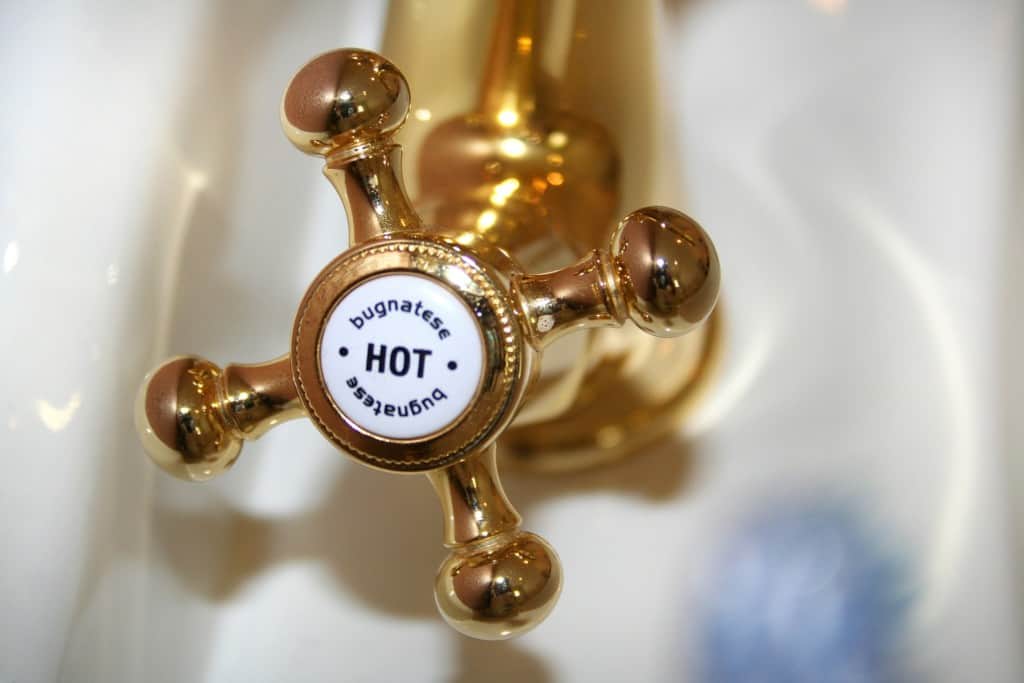
A cloudy or milky appearance in hot water is usually the result of dissolved oxygen bubbles trying to escape from the water which can be caused by a couple of different things.
However, there are some other reasons why your hot water might be cloudy.
1. Dirty Faucet Aerator
This is the most common cause of cloudy water, the faucet aerator is dirty and is causing more trapped air bubbles to be in the water than usual.
A faucet aerator is a mesh cap put on the end of your faucet to help prevent excessive splashing.
The aerator can get mineral deposits built up on it especially if you have hard water. Although they are harmless, these deposits will increase the pressure on the water coming out of your faucet which will increase the number of tiny bubbles, creating a cloudy appearance.
2. Process Of Heating The Water
Another reason why your hot water is cloudy could be the process of heating up the water in the hot water system.
Cold water can hold more dissolved oxygen than hot water. So, when you heat up the water, this dissolved oxygen is no longer held in place by the water and is trying to escape.
Much like when you open a can of carbonated soda, the oxygen is bubbling out of the water as quickly as it can, and it can’t get out until it’s through your plumbing system and out your faucet.
3. Sediment Build-Up
Another main reason your hot water could be cloudy is that your water has sediment in it. Now don’t panic, this isn’t as common as dissolved oxygen but it’s worth mentioning.
Sediment in your hot water is usually caused by minerals building up in your hot water heater over time. This is especially likely if you have hard water. If too much sediment builds up in your water heater, it can make its way through your plumbing and out your faucet causing cloudy water.
If you find that you have sediment in your water, avoid drinking it and stick to bottled water or other filtered water until you can get the problem fixed.
4. High Water Pressure
Everyone loves a good high-pressure shower, but having extremely high water pressure can cause both your cold tap water and hot tap water to be cloudy.
High water pressure agitates water more than low water pressure. This agitation causes more tiny air bubbles to get trapped in the water than usual. This can give your water a milky appearance.
If you have high water pressure and cloudy water, the water pressure is likely causing your issues.
5. Hard Water
Having hard water can cause your hot water to be cloudy. Hard water is just a term used for water that has a high mineral content.
This is especially common in rural areas, you can check with the local water companies to tell if you live in a hard water area.
You can tell if you have hard water if your showers get rusty residue in them or if you get limescale build-up (chalky white deposits) in tea kettles or after boiling water down.
Hard water is safe to drink, but it can sometimes have a taste that some people don’t like, I personally don’t mind it.
If you have hard water, water softener systems can help ‘soften’ the water and make it less hard. You can also filter your drinking water if you don’t like the taste.
6. Water Supply Shut Off
This is not a very common reason, but if you normally don’t have cloudy water and then suddenly you do, it could be an issue with your water source or part of your water supply being shut off.
When maintenance needs to be done on water lines, the water mains to that line have to be shut off. This can cause more air than usual to get in your water line.
If this is the case for you, check the local water companies to see if any maintenance is going on that would effect you.
Now that we’ve covered the main causes of cloudy water, we’re going to go over an easy way to identify which of these problems you’re experiencing.
How to Identify the Problem

Before we get started with identifying the cause of the problem, you’re going to need a very important tool.
A see-through container or a clear glass.
That’s it. It can be a glass, a bowl, a mason jar, or a plastic container. Heck, if you have a graduated cylinder lying around use that. It doesn’t matter, it just has to hold water and be see-through.
All you have to do for this test is turn on your faucet until you get hot water and then fill your container with water, basically just get a glass of water.
Once it’s filled, set it on a flat surface and watch it. It should be slightly more entertaining than watching paint dry.
While you’re watching your cloudy water, look for two things:
- Which direction does the water clear, from the bottom up or the top down?
- How long does it take to clear, if at all?
If your glass clears in just a few minutes and it clears from the bottom up, congratulations, you have oxygen bubbles in your water.
If it clears from the top down and takes longer to clear, you probably have sediment in your water.
If your water doesn’t clear within 24 hours or your water has a brown color instead of white, it’s possible that they may be doing maintenance on a water main or something similar. Call your water provider to find out if that’s the case.
You should try this test on all of the faucets in your home.
If only one faucet produces cloudy water, you may have a dirty aerator. If it occurs in all of your faucets, there may be something wrong with your plumbing or your water heater.
How to Fix Cloudy Hot Water
After performing that simple test, here are some things you can do to fix your cloudy hot water.
1. Clean Your Water Aerator
If only one or two sinks give you cloudy water, then the easiest thing to try is to clean your sink’s aerator.
This is super simple and free to do, so if you’re not sure what the cause is, then try this first.
Skip to this section for a step-by-step guide on how to clean your water aerator.
2. Get a Water Softener System
If you think your cloudy hot water could be caused by hard water, then it might to time to install a softener system.
Consult with an expert before you spend the money just to make sure it will fix the problem.
If you already have a water softener system, check the tank. You may need to add water softener salt. When your system runs out of this salt, it will no longer be able to soften the water.
3. Adjust the Water Pressure
A high-pressure shower can be amazing, but there is a point when the water pressure is too high. If you think high water pressure is the cause of your cloudy water, you can adjust the water pressure.
This really only works if you live in a house, people in apartments may not have this option. Here’s a great video showing you how to adjust your water pressure regulator.
If doing this makes you nervous or you can’t find your water pressure relief valve, don’t hesitate to call a licensed plumber.
How to Clean A Sink Water Aerator
If you think you have a dirty or clogged aerator, you just need to take it off and clean it. I did this with my kitchen sink in about ten minutes, here’s how you do it.
Step 1: Remove the Aerator
First, you’ll need to remove the aerator from your faucet. You can do this by turning the bottom of your faucet clockwise.
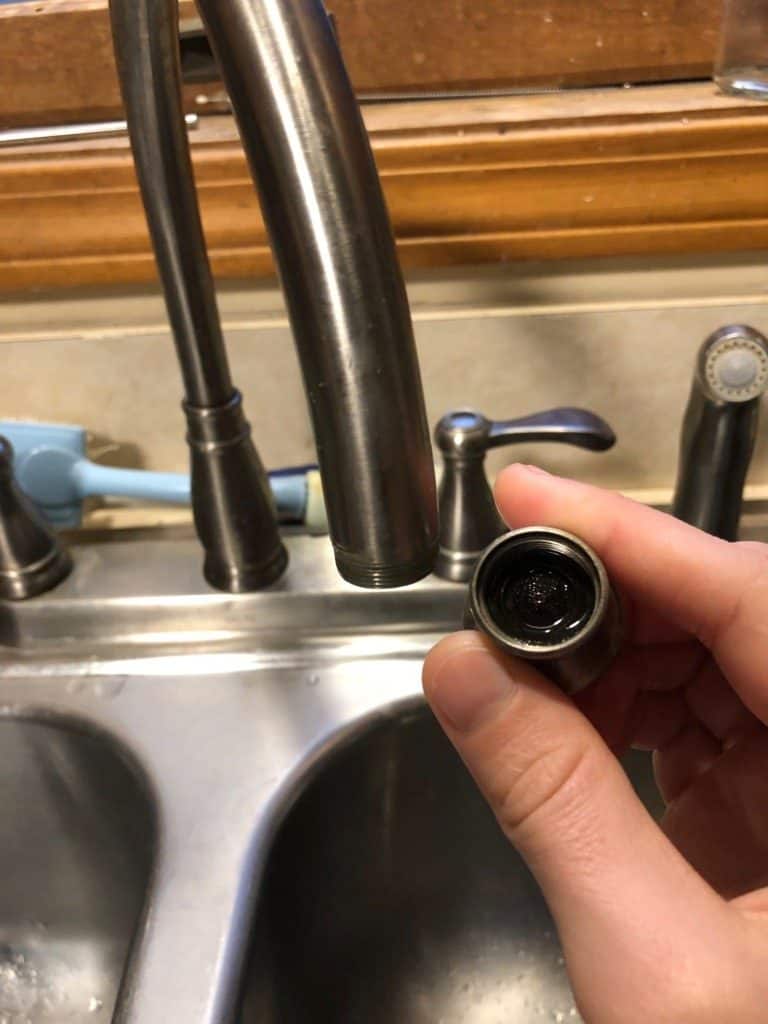
You may be able to do this with just finger strength, but if it’s too tight you’ll have to use a wrench. If you have to use a wrench, wrap the end of the faucet in a towel or cloth so you don’t scratch the metal.
Step 2: Clean the Aerator
Once you’ve removed the aerator, check both sides for any gunk built up. You can see the hard water sediment built up on my aerator in the picture below. Simply clean it off using a washcloth or a scrubby brush.
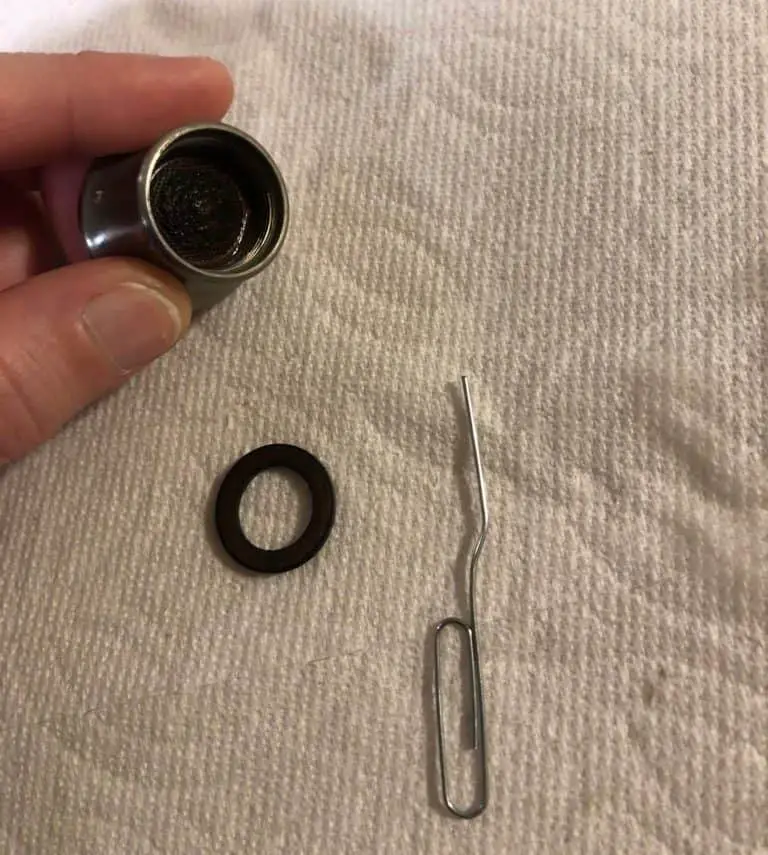
Your aerator may have removable parts. If it does, make sure you remember to put them back in using the same order they came out.
If the holes in the mesh are covered, you can use a toothpick or needle to get the sediment out. Also, if the deposits are too hard to remove, you can soak the aerator in vinegar overnight to loosen it.

Before you replace your aerator, run your faucet for a few minutes to remove any build-up that may be hidden up the pipe.
If you’re feeling extra motivated, you can use a pipe cleaner or a small brush to clean around the inside of the faucet.
Step 3: Replace the Aerator
Once it’s clean, screw it back onto your faucet turning it counterclockwise. No need to use the wrench again, just finger-tighten it the best you can.
And, voila, you have cleaned your aerator.
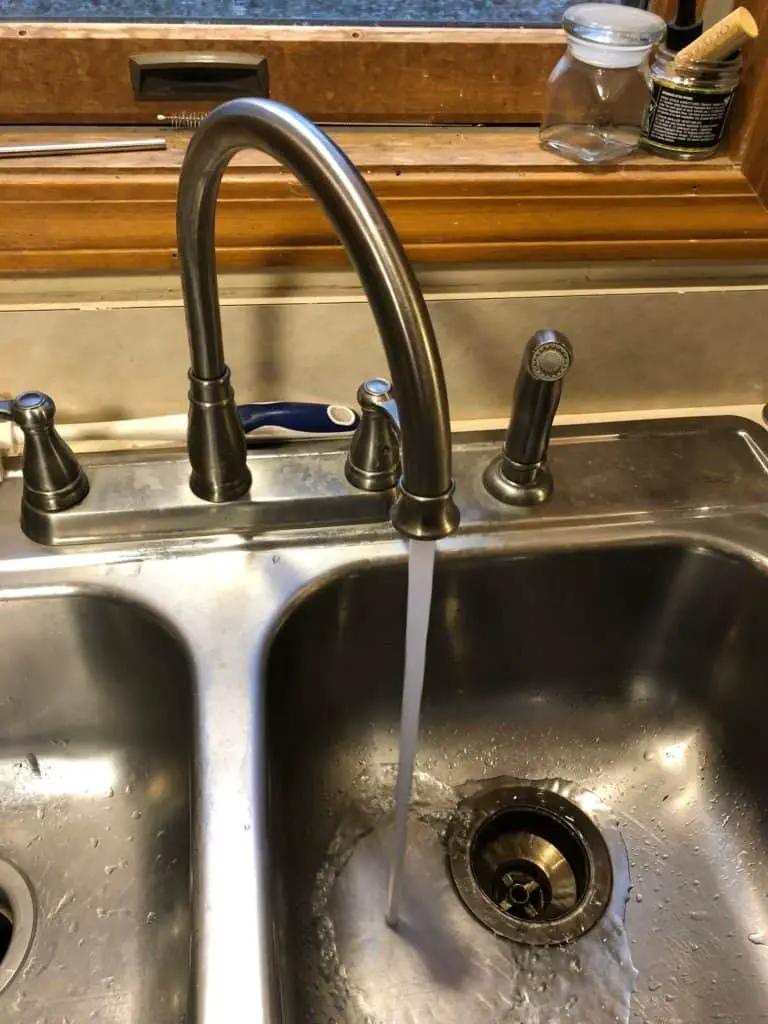
Once your aerator is replaced, try the water test again to see if you still have cloudy water. If it’s still cloudy, you may have a bigger issue.
When to Call a Professional
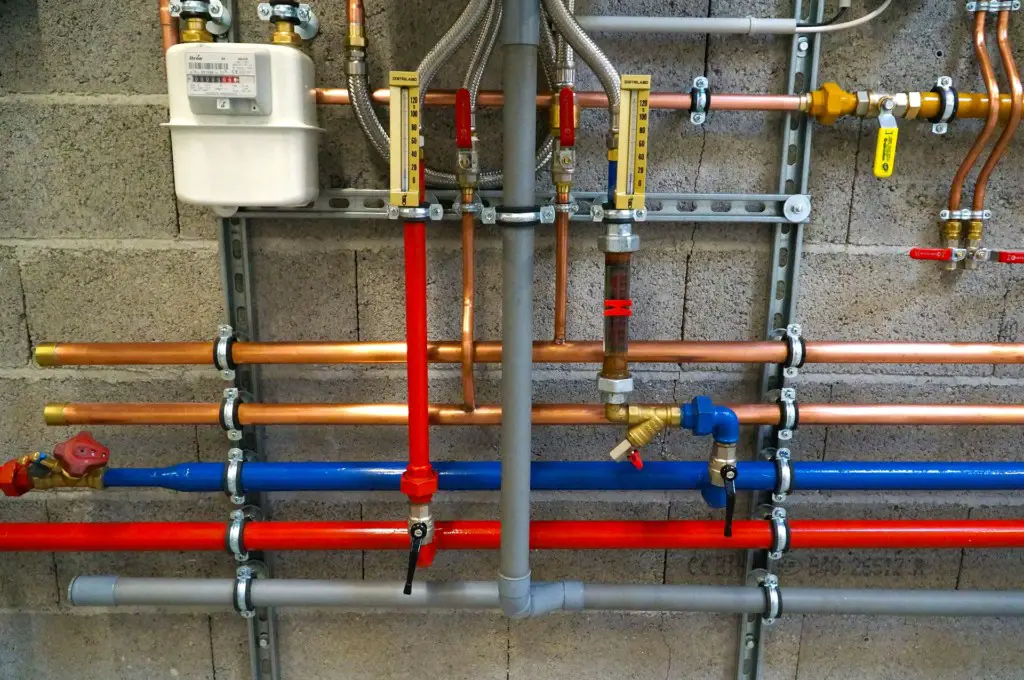
Trying to fix this problem yourself is great, but, sometimes you need some help from a professional plumber.
After you perform the above water test and believe you have sediment in your water, it’s time to call a pro. Sediment can mean your water heater needs to be flushed or that the water company is doing some maintenance.
Call your water company to ask about maintenance first. If there’s no maintenance you might want to ask your neighbors if they are experiencing the same problem.
If no one is having the same issue, then it’s time to call a plumber. They can not only come to your home and identify the problem but also give you helpful information over the phone.
Also, if you tried cleaning your aerator and you still have cloudy water, this may be a sign of problems with your plumbing or water heater issues. Call your local plumbing professional and they’ll help you sort it out.
Related Questions
Can I Have Cloudy Hot Water and Clear Cold Water?
Because cold water can hold more dissolved oxygen than hot water, it’s likely that your cold water will be clear even if your hot water is cloudy. This is true even when using the same sink or faucet.
How Do I Fix Cloudy Tap Water?
The easiest way to fix cloudy tap water is by cleaning or replacing the faucet’s water aerator, but this solution only works in certain cases. If this is not the issue, then the problem is probably being caused by sediment or the hot water heater, and you may need to get a professional involved.
